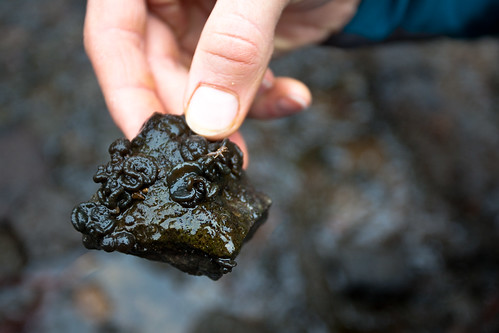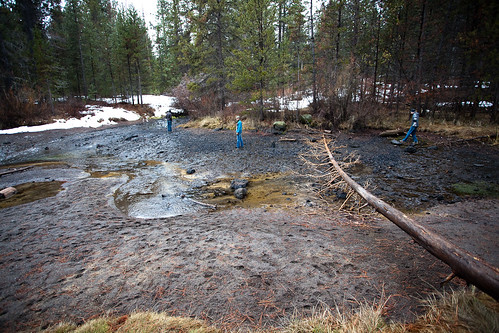Along the Deschutes: Three eras, one place
February 14, 2010
It is a running joke, at least to me, about how the resort community of Sunriver, Ore., is kryptonite to my navigational super-skills. It’s like the Island from Lost for me here: my internal compass pegs on north or spins senselessly, as if we’re constantly and unpredictably flinging around through electromagnetically unstable space-time. Because the pseudo-townlet is laid out on a recursive nesting of whirls within whirls (furled subdivisions like capillaries, madly-random traffic circles pumping out confused SUVs towards tennis courts and lodgepole pines) I am not convinced that it’s not fractal: start unwinding all of these streets and sub-streets into a line and you might approach the infinite.
In September of 1855, long before the leisured masses descended and the condos mass-built, Lieutenant Henry Larcom Abbot was having a rough moment with a horse. The beast, confused or mishandled, had just tripped through the cords of a tent and, in the melee, destroyed a barometer.
Not an auspicious first day for Abbot. The fresh-faced engineer had just been handed the reins (figuratively and literally) by his superior, Lieutenant R. S. Williamson, to explore the Deschutes River valley.
Accompanied by several topographical engineers, pack mules, porters, and soldiers, the two lieutenants led a pioneering survey of Northern California and Central Oregon, in search of possible railroad routes.
Even their instructions seemed resigned to the failure of this primary goal, noting that
“[a]long Des Chutes river the character of the country is such as to render it improbable that a practicable route can be found.” The expedition did, however, provide some of the earliest scientific and cartographic information about the volcanic, arid, and mysterious interior high desert region of Oregon. The horse-crushed barometer on that September morning struck a blow to the meticulous, organized engineers.
After camping along the Deschutes River very near where I am typing at this moment, Williamson and Abbot split up. Williamson headed into the mountains, while Abbot explored the high desert environs of the Deschutes up to its confluence with the Columbia at The Dalles, Ore.
Abbot’s careful observations helped explain the area to Americans, and in turn his name lived on. The U.S. Army developed a short-lived but successful training facility here during World War II. Between 1943 and 1944—barely more than a year—90,000 combat engineers were processed and trained in Camp Abbot under the leadership of Colonel Frank Besson.
The only remaining remnant of the camp is the officers’ mess, which serves as Sunriver Resort’s “Great Hall.”
“In examining the vicinity of camp this morning, I found the remains of an old Indian rancheria, surrounded by numerous deer and elk horns. A little above the crossing on the western bank, several springs gushed from the rocks and united to form a stream nearly fifteen feet in width, which discharged itself into the river.”
—Lt. Henry Larcom Abbot, Sept. 3, 1855
Today I returned to a site that ties the three histories together: Abbot’s exploration and report, WWII’s Col. Besson, and the current era of Sunriver. I visited the Besson Day Use area, a place David and I discovered last year after peering at local maps and noting that there seemed to be robust springs in the area.
At the Besson site, a wide swath of rocky and sandy ground bubbles lightly and forms a series of streams that join and then flow into the Deschutes just beyond. It’s a slightly magical place, with odd-colored algae, deeply black basaltic rocks, and roiling underwater silt where the water burbles in. The place looks quite different than it did last year; the patterns of precipitation and season change the locations and intensity of the springs.
I like it there, the place first described by Abbot, named after Besson and re-discovered by the Pencils.
Sources
- Reports of explorations and surveys, to ascertain the most practicable and economical route for a railroad from the Mississippi River to the Pacific Ocean, United States War Dept., 1855
- Abbot, Charles Greeley, Biographical Memoir of Henry Larcom Abbot, National Academy of Sciences, Washington, D.C., 1929.
- http://en.wikipedia.org/wiki/Camp_Abbot
Related Posts
- This Desert Thing: A Continuing Interlude
January 29, 2009 - *River Trip of the Week
February 24, 2007 - Camping FAIL
April 13, 2008 - Books: The Kings and Queens of England (Plantagent Somerset Fry)
December 14, 2006 - Playing with Rocks
April 22, 2008



